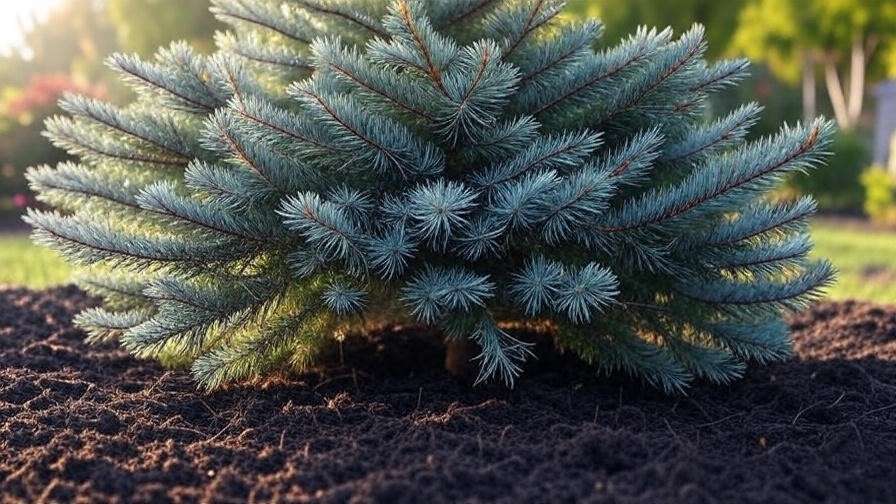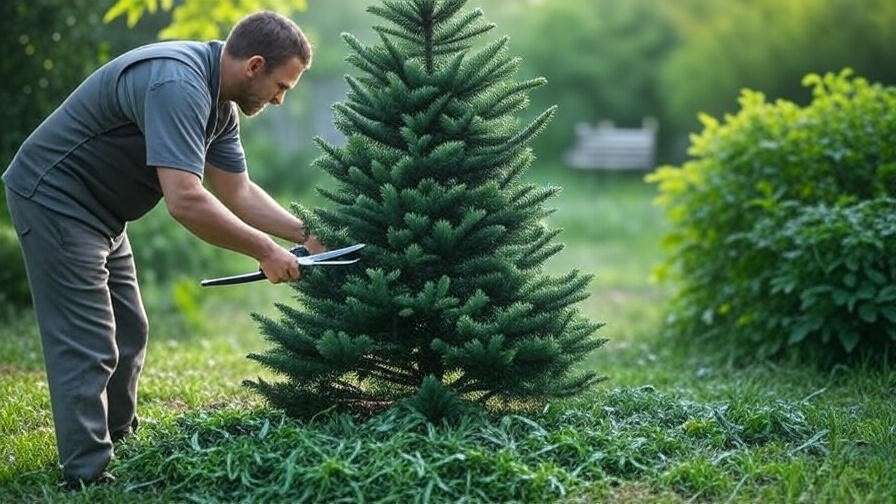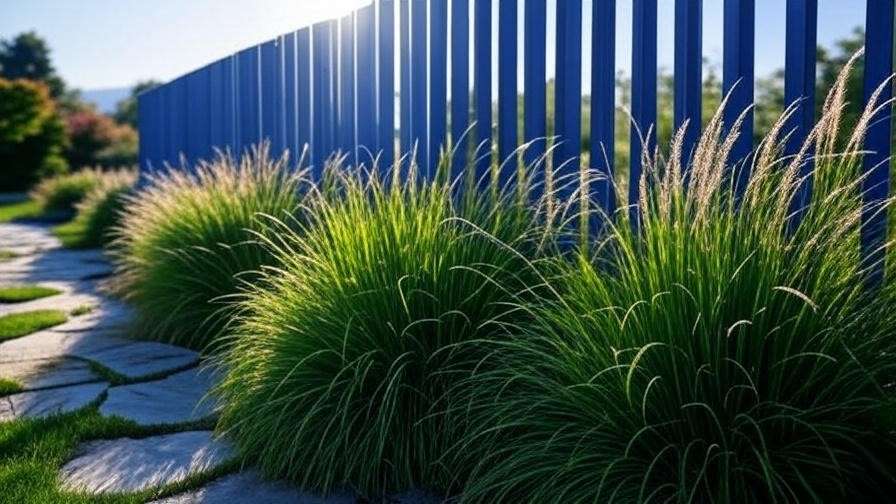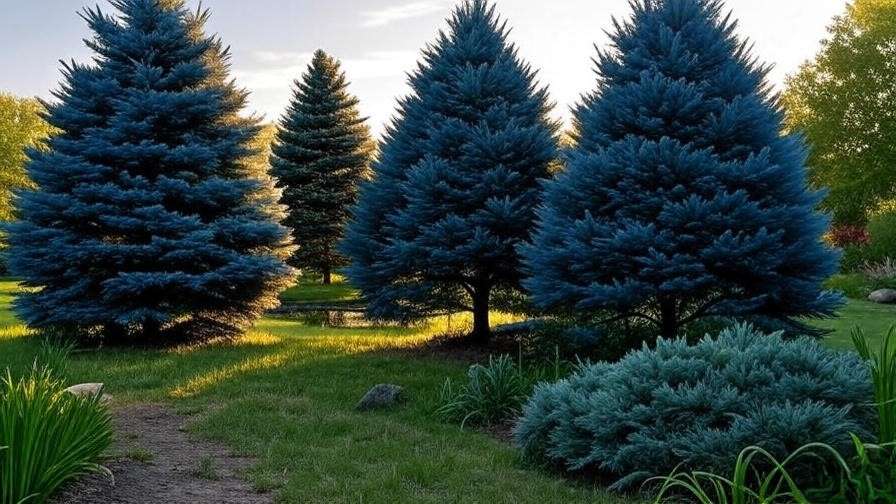Imagine stepping into your backyard and being greeted by the breathtaking sight of vibrant blue evergreen trees, their icy needles shimmering under the sun, transforming your garden into a year-round masterpiece. These striking trees, like the iconic Colorado Blue Spruce or the elegant Blue Atlas Cedar, are more than just eye candy—they’re a gardener’s dream for adding structure, color, and charm to any landscape. But growing healthy blue evergreen trees isn’t always straightforward. Many gardeners face challenges like browning needles or stunted growth due to improper care. Don’t worry! As a horticulturist with over a decade of experience in tree care, I’ve crafted this comprehensive guide to share seven essential, research-backed tips to help you grow stunning blue evergreen trees that thrive for years. Backed by insights from university extension programs and arborist expertise, this article will empower you to overcome common pitfalls and create a vibrant, low-maintenance garden centerpiece. Let’s dive in! 🌟
Why Choose Blue Evergreen Trees for Your Garden? 🌟
Blue evergreen trees are a standout choice for homeowners and gardeners looking to elevate their outdoor spaces. Their unique aesthetic, practical benefits, and diverse varieties make them a must-have for any landscape.
Unique Aesthetic Appeal
The hallmark of blue evergreen trees is their striking blue-green foliage, which adds a bold contrast to traditional green landscapes. For example, the Colorado Blue Spruce (Picea pungens) boasts silvery-blue needles that catch the light beautifully, creating a serene, almost magical ambiance. Unlike deciduous trees that shed seasonally, these evergreens maintain their vibrant color year-round, ensuring your garden stays lively even in winter. Their conical or pyramidal shapes also add architectural elegance, making them perfect as focal points or natural privacy screens.
Environmental and Practical Benefits
Beyond beauty, blue evergreen trees offer significant environmental advantages. They act as natural windbreaks, reducing heating costs by up to 20% in winter, according to the USDA Forest Service. They also provide year-round privacy, block unsightly views, and create habitats for birds and small wildlife. Their dense foliage sequesters carbon, contributing to a healthier planet. Plus, once established, most blue evergreens require minimal maintenance compared to flowering shrubs or deciduous trees, saving you time and effort.
Popular Varieties of Blue Evergreen Trees
Not all blue evergreens are created equal! Here’s a quick guide to some popular varieties, each suited to different climates and garden styles:
| Variety | Mature Height | USDA Hardiness Zones | Key Features |
|---|---|---|---|
| Colorado Blue Spruce | 30-60 ft | 2-7 | Silvery-blue needles, classic conical shape |
| Blue Atlas Cedar | 40-60 ft | 6-9 | Graceful, drooping branches, soft blue needles |
| Serbian Spruce | 50-60 ft | 4-7 | Slender form, glossy blue-green needles |
| Blue Noble Fir | 50-100 ft | 4-6 | Lush, soft needles, ideal for colder climates |
Choosing the right variety sets the foundation for success, so let’s explore how to match these trees to your garden’s needs.
Tip 1: Selecting the Right Blue Evergreen for Your Climate 🌍
The first step to growing healthy blue evergreen trees is choosing a variety that thrives in your local climate. The USDA Hardiness Zone map is your best friend here. For instance, Colorado Blue Spruce excels in colder regions (Zones 2-7), while Blue Atlas Cedar prefers milder climates (Zones 6-9). Research your local temperature ranges and frost dates using resources like the USDA Plant Database or your local extension service.
Consider your garden’s microclimate, too. Does your yard have a sunny, exposed area or a shaded, sheltered spot? Most blue evergreens prefer full sun, but some, like Serbian Spruce, tolerate partial shade. Consulting with a local arborist or nursery can provide tailored recommendations. For example, I once helped a client in Zone 5 select a Serbian Spruce for their partially shaded yard, and it’s now a thriving centerpiece.
Pro Tip: Check your soil type and drainage before selecting a variety. Blue evergreens generally prefer well-draining, slightly acidic soils, which we’ll cover next.
Tip 2: Preparing the Perfect Planting Site 🕳️
A well-prepared planting site is crucial for your blue evergreen’s long-term health. Let’s break down the key elements.
Soil Requirements
Blue evergreen trees thrive in well-draining, slightly acidic soils (pH 5.5-6.5). Test your soil’s pH with a home testing kit, available at most garden centers. If your soil is too alkaline, amend it with organic matter like peat moss or compost. For heavy clay soils, mix in sand or perlite to improve drainage. Poor drainage can lead to root rot, a common killer of young evergreens. According to a study by the University of Minnesota Extension, proper soil preparation can increase tree survival rates by up to 30%.

Sunlight and Space Needs
Most blue evergreens need at least six hours of direct sunlight daily to maintain their vibrant needle color. Position your tree in an open area away from tall structures or trees that cast shade. Spacing is equally important—plant trees 10-20 feet apart, depending on their mature size, to prevent overcrowding. For example, a Blue Atlas Cedar needs ample room to spread its graceful branches, while a Serbian Spruce’s slender form suits tighter spaces.
Avoiding Common Planting Mistakes
Planting too deep or in waterlogged areas is a recipe for disaster. Dig a hole twice as wide as the root ball but no deeper, ensuring the root flare sits just above ground level. Here’s a quick planting checklist:
- Test and amend soil pH.
- Dig a wide, shallow hole.
- Remove burlap or containers from the root ball.
- Backfill with native soil mixed with compost.
- Water thoroughly after planting.
Tip 3: Watering Blue Evergreen Trees Properly 💧
Watering is critical, especially during the first two years when your blue evergreen is establishing its roots. Young trees need deep, weekly watering—about 1-2 inches of water, adjusted for rainfall. Use a soaker hose or drip irrigation for even distribution, as overhead watering can promote fungal diseases.
Mature trees are more drought-tolerant but still need supplemental water during prolonged dry spells. Check soil moisture by digging 2-3 inches down; if it’s dry, it’s time to water. Watch for signs of stress: yellowing needles indicate overwatering, while brittle, brown needles suggest underwatering. A client of mine once saved a struggling Blue Spruce by switching to a drip system, which delivered consistent moisture without waterlogging.
Expert Tip: Water deeply in late fall to hydrate roots before winter dormancy, reducing the risk of winter burn.

Tip 4: Fertilizing for Vibrant Growth 🌿
Fertilizing blue evergreen trees promotes lush, vibrant growth, but timing and technique matter. Apply a slow-release, balanced fertilizer (e.g., 10-10-10 or 12-4-8) in early spring, just before new growth begins. Spread it evenly around the drip line (the area under the outermost branches), avoiding direct contact with the trunk.
Over-fertilization can burn roots or cause excessive, weak growth, so follow package instructions carefully. For example, a gardener I advised revived a lackluster Blue Noble Fir by applying a half-strength dose of fertilizer annually, resulting in brighter needles within months. If your soil test shows nutrient deficiencies, consider a targeted fertilizer with micronutrients like iron or magnesium.
Tip 5: Pruning and Shaping for Health and Beauty ✂️
Pruning keeps your blue evergreen healthy and enhances its natural shape, but it’s all about timing and technique.
When to Prune
Late winter or early spring, before new growth starts, is the ideal time to prune. This minimizes stress and allows the tree to heal quickly. Focus on removing dead, damaged, or crossing branches to improve air circulation and reduce disease risk.

Pruning Techniques
Use clean, sharp pruning shears to make angled cuts just outside the branch collar. Avoid cutting into old wood, as most evergreens won’t regrow from these areas. For a visual guide, imagine pruning a Colorado Blue Spruce to maintain its iconic conical shape—remove only what’s necessary to keep it tidy.
Shaping for Aesthetic Appeal
Blue evergreens shine as living Christmas trees or focal points. To maintain their shape, lightly trim new growth (candles) in spring. For example, pinching back one-third of the new growth on a Blue Spruce encourages denser foliage. A client once transformed their sparse spruce into a lush centerpiece with consistent, light shaping over two seasons.
Tip 6: Protecting Blue Evergreens from Pests and Diseases 🐞
Healthy blue evergreen trees are resilient, but pests and diseases can strike if care lapses. Here’s how to stay ahead.
Common Pests
Spider mites and spruce gall adelgids are common culprits. Spider mites cause stippling or webbing on needles, while adelgids create cone-like galls at branch tips. Check your tree regularly, especially in hot, dry weather. For eco-friendly control, spray neem oil or insecticidal soap. For severe infestations, consult an arborist for targeted treatments. A study by the University of California IPM program found that early detection reduces pest damage by up to 50%.
Common Diseases
Needle cast, caused by fungi like Rhizosphaera, leads to needle drop and browning. Prevent it with good spacing, proper watering, and annual fungicide sprays in spring, if needed. Root rot, often due to poor drainage, can be avoided by planting in well-draining soil. Here’s a quick reference:
| Issue | Symptoms | Treatment/Prevention |
|---|---|---|
| Spider Mites | Stippling, webbing on needles | Neem oil, increase humidity |
| Spruce Gall Adelgids | Galls at branch tips | Horticultural oil, prune affected areas |
| Needle Cast | Purple-brown needles, needle drop | Fungicide, improve air circulation |
| Root Rot | Wilting, yellowing needles | Improve drainage, avoid overwatering |
Expert Insight: Regular inspections and integrated pest management (IPM) practices, as recommended by Cornell University, are key to keeping your trees pest-free.
Tip 7: Winter Care for Blue Evergreen Trees ❄️
Winter can be tough on blue evergreen trees, especially in regions with harsh freezes or heavy snow. Proper preparation ensures they emerge in spring as vibrant as ever. Start by watering deeply in late fall, before the ground freezes, to hydrate roots and prevent winter drought—a common cause of needle browning, according to the University of Wisconsin Extension. Apply 2-3 inches of organic mulch, like shredded bark, around the base (keeping it away from the trunk) to insulate roots and retain moisture.
For young trees, wrap them in burlap to shield against drying winds and sunscald, which can damage exposed needles. In snowy areas, gently brush heavy snow off branches to prevent breakage, especially for varieties like Blue Atlas Cedar with softer, drooping limbs. Avoid using de-icing salts near your trees, as salt can burn roots and dull needle color. A gardener I worked with in Zone 4 saved their young Colorado Blue Spruce from winter burn by wrapping it in burlap and maintaining a consistent watering schedule through fall, resulting in a healthy, vibrant tree come spring.
Pro Tip: If you notice brown needles in late winter, don’t panic—it could be natural needle drop. Older needles (3-5 years old) often shed in fall or winter, but new growth should remain vibrant.
Troubleshooting Common Blue Evergreen Problems 🔍
Even with the best care, blue evergreen trees can face challenges. Here’s how to diagnose and fix common issues to keep your trees thriving.
- Browning Needles: This could stem from underwatering, overwatering, or winter burn. Check soil moisture (2-3 inches deep) and adjust watering. If winter burn is the culprit, increase fall watering and consider burlap wrapping next season.
- Slow Growth: Poor soil nutrients or insufficient sunlight often cause stunted growth. Test soil for deficiencies and fertilize appropriately (see Tip 4). Ensure the tree gets 6+ hours of direct sun daily.
- Sparse Foliage: Overcrowding or improper pruning may reduce density. Space trees adequately at planting and prune lightly to encourage fuller growth.
Diagnostic Checklist:
- Test soil moisture and pH.
- Inspect for pests (e.g., spider mites, adelgids) or disease signs (e.g., needle cast).
- Confirm adequate sunlight and spacing.
- Review fertilization and pruning history.
FAQs:
- Why are my blue evergreen’s needles turning brown? Browning often indicates water stress or winter burn. Check soil moisture and ensure proper fall watering.
- Can I grow a blue evergreen in a container? Yes, dwarf varieties like Fat Albert Blue Spruce work well in large containers with well-draining soil, but they need consistent care.
- How long does it take for a blue evergreen to reach full size? Most varieties take 20-30 years to reach mature height, depending on species and conditions.
For persistent issues, consult a local extension service or arborist. The American Conifer Society offers excellent resources for diagnosing evergreen problems.
Enhancing Your Landscape with Blue Evergreen Trees 🎨
Blue evergreen trees are versatile design elements that elevate any garden. Use a Colorado Blue Spruce as a striking focal point in a front yard, its silvery needles drawing the eye. For a natural privacy screen, plant a row of Serbian Spruces along a property line—their slender form maximizes space while adding elegance. Blue Atlas Cedars, with their graceful, drooping branches, pair beautifully with low-growing ornamental grasses or vibrant perennials like lavender or salvia, creating a harmonious color palette.
For small gardens, consider dwarf varieties like Blue Mound Spruce, which stays under 10 feet tall but delivers the same stunning hue. Mix textures by combining blue evergreens with broadleaf evergreens like holly or flowering shrubs like hydrangeas. A client of mine transformed their small urban yard by planting a single Blue Noble Fir as a centerpiece, surrounded by colorful annuals, creating a vibrant, low-maintenance display.

Design Inspiration:
- Focal Point: A lone Blue Spruce in a lawn, accented with a circular mulch bed and low-growing perennials.
- Hedge: Serbian Spruces planted 8-10 feet apart for a sleek, modern privacy screen.
- Mixed Border: Blue Atlas Cedar paired with ornamental grasses and stone accents for a Mediterranean vibe.
Conclusion 🌲
Growing stunning blue evergreen trees is within your reach with these seven essential tips: selecting the right variety, preparing the perfect site, watering wisely, fertilizing strategically, pruning properly, protecting against pests and diseases, and providing winter care. These steps, grounded in decades of horticultural experience and backed by research from sources like the USDA and university extension programs, ensure your trees thrive as vibrant garden centerpieces. Whether you’re dreaming of a single Blue Spruce or a row of Serbian Spruces, you now have the tools to succeed.
Ready to transform your landscape? Start by choosing a blue evergreen suited to your climate and follow these expert tips for lasting success. Share your journey or ask questions in the comments below, and explore our related articles, like “Top 10 Evergreen Shrubs for Small Gardens,” for more inspiration. Happy planting! 🌱













